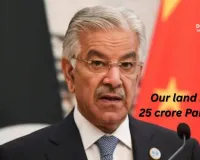India-US Trade Talks Heat Up: Piyush Goyal's Firm Stance on 'No Rush' Amid Tariff Tensions
Digital Desk

In a bold assertion that underscores India's unwavering negotiation strategy, Union Commerce and Industry Minister Piyush Goyal has declared that New Delhi will not be coerced into hasty trade deals with the United States, especially not "with a gun to our head."
Speaking from Berlin amid parallel discussions on the India-EU Free Trade Agreement (FTA), Goyal's remarks come at a critical juncture in the India-US Bilateral Trade Agreement (BTA) talks, strained by escalating US tariffs on Indian exports.
The minister's stern message arrives as the two global economic powerhouses navigate a complex web of tariff impositions and geopolitical pressures. The US has slapped 50% tariffs on several Indian goods, a move partly attributed to India's continued purchases of discounted Russian crude oil amid the Ukraine conflict.
Goyal questioned the selective penalties, pointing out that allies like Germany and the UK have reportedly secured exemptions from similar third-country sanctions. "We don't do deals in a hurry and we don't do deals with deadlines or with a gun on our head," Goyal emphasized in an interview with Doordarshan, highlighting India's commitment to equitable partnerships built on mutual trust rather than arm-twisting.
Progress in India-US Trade Negotiations: A Glimmer of Hope?
Despite the rhetoric, optimism lingers in diplomatic circles. Launched in February 2025 at the behest of leaders from both nations, the BTA negotiations have completed five intensive rounds, with the first tranche targeted for conclusion by October-November 2025.
Recent high-level engagements, including Commerce Secretary Rajesh Agrawal's Washington visit last week and Goyal's New York delegation last month, signal steady headway. Sources indicate negotiators are now drafting textual language, though a final seal will hinge on "political convergence."
The proposed pact aims to slash those punitive US tariffs and propel bilateral trade currently hovering around $200 billion to an ambitious $500 billion by 2030.
Key areas under discussion include market access, rules of origin, environmental standards, and safeguards for sensitive sectors like agriculture and dairy. Goyal reiterated that India seeks a "fair and equitable agreement" that aligns with its Atmanirbhar Bharat (self-reliant India) vision, rejecting any clauses that curtail strategic autonomy in energy sourcing or global supply chains.
Even the ongoing US government shutdown hasn't derailed momentum. Goyal noted continuous dialogue, with potential for in-person meetings soon, affirming,
"Talks are progressing, and we hope to work towards a fair and equitable agreement in the near future." This resilience echoes Goyal's earlier warnings against "weaponizing trade," a subtle nod to the Trump administration's protectionist policies.
Challenges and Broader Implications for Global Trade
The tariff tensions aren't isolated; they mirror wider frictions with the EU and UK, where similar demands to curb Russian oil imports persist.
India's refusal to yield reflects a maturing economy unwilling to compromise on energy security for short-term gains. Failure to bridge these gaps could exacerbate supply chain disruptions and inflate costs for Indian exporters in textiles, pharmaceuticals, and IT services sectors vital to millions of jobs.
Yet, a breakthrough BTA could redefine Indo-US ties, fostering deeper investment flows and technological collaborations. As Goyal put it, "Trade deals are about businesses and long-term implications for a $30-trillion economy in 20-25 years." With deadlines looming, all eyes are on Washington and New Delhi for signs of compromise.
In the chessboard of global trade, Goyal's measured tone positions India not as a supplicant, but a strategic player demanding respect. As negotiations intensify, stakeholders from Mumbai's boardrooms to Washington's corridors brace for outcomes that could reshape economic destinies.











